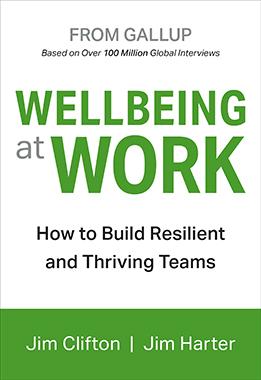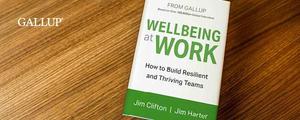Story Highlights
- High workplace wellbeing improves how well employees bounce back
- To improve employee wellbeing, managers need to improve their own
- CliftonStrengths and a sense of purpose make a big difference
Only 44% of employees believe they can always "bounce back" from hardship. That's a sobering number as employee mental health and wellbeing erode in these unprecedented times. And it packs a prediction about resilience that people and leaders must grapple with.
Those leaders, some of whom are close to burnout themselves, have their work cut out for them. The good news is this: Human psychological needs are no enigma. When leaders fulfill the four needs of followers -- a sense of trust, compassion, stability and hope -- they are more likely to catalyze resilience, performance and respect in the workplace.
In fact, 59% of employees who strongly agree that their organization cares about their overall wellbeing believe they can always bounce back after hardship. But only one in four employees strongly agree that their organization cares.
Positive change begins at the most local level: the individual. Before meeting the needs of others, managers can reinforce their own wellbeing by strengthening their connection to their sense of self, to their team and to the company mission.
Here's how.
First, focus on yourself
Your CliftonStrengths are the result of your innate wiring -- the natural patterns of thought, feeling and behavior that come to you. And in a rapidly changing environment, your strengths are constants you can rely on -- and capitalize on -- to improve your situation. So, ask yourself:
- What has changed for me since the COVID-19 outbreak? What hasn't changed?
- What was I doing when I felt "at my best" recently?
With that in mind, think about how you can do more of what led you to excellence. Gallup finds that resilience is closely related to the ability to do what you do best -- almost as much as a sense of mission and purpose and the belief that your opinions count.
Think about the actions you can take today and tomorrow to improve your current situation.
Second, think about the team
The best teams can be counted on to care, speak up and get things done no matter what. In fact, employees who say their organization cares about their wellbeing are five times more likely to also strongly agree that when something goes wrong, their team looks for solutions rather than blaming each other.
Clearly, your team will be more resilient if you proactively tighten your team's connections. Therefore, ask yourself and your team:
- What do team members say has changed for them, and what hasn't?
- When has the team been at their best during the last week?
- How has the team used and applauded their collective strengths?
- Who can I best partner with to create positive change and move others toward action?
Third, align with the company mission
People need a purpose larger than themselves. It fuels resilience and daily motivation, especially during difficult times. Don't lose sight of your value and your impact on the mission. So, ask yourself:
- What are our company's stable values? How am I living up to them?
- As a company, how have we capitalized on our strengths in the last seven days?
- How can we become even stronger in the days to come?
- What action(s) can I initiate today to cultivate our corporate strengths which, in turn, keep our culture alive?
People need a purpose larger than themselves. It fuels resilience and daily motivation, especially during difficult times.
The 59% of workers who feel they can always bounce back from hardship work in very different companies, but they share a sense that their organization cares about them. By claiming and aiming their strengths, anyone can cultivate this same confidence in the workplace and in their ability to rebound from adversity.
The effect will be far greater if their manager incorporates the practices above. But the greatest impact comes from leaders' commitment to employee wellbeing -- and a wellness program isn't enough.
Improve workplace wellbeing through clear communication
In one client study during the early days of the pandemic -- conducted in a predominantly blue-collar organization -- Gallup found that employees who said their leaders clearly communicated plans were much more likely to feel safe and cared for than respondents who didn't feel leaders effectively communicated with them.
Furthermore, employees who strongly agreed their manager kept them informed about their company's plans were also four times more likely to feel their company fully cares for their best interest. Leaders saw a noticeable increase in resiliency among these same employees -- especially for blue-collar workers, whose belief in their ability to fully bounce back from hardship exceeded their white-collar peers by 13 percentage points.
Like many managers of blue-collar workers, a manager's span of control in this organization is much larger than the typical white-collar manager's, and most of their employees have little to no control over their time and few channels of communication. Gallup's analysis encouraged the company to step up its communication, and as a result, employees became vastly more likely to feel cared for.
The 59% of workers who feel they can always bounce back from hardship work in very different companies, but they share a sense that their organization cares about them. By claiming and aiming their strengths, anyone can cultivate this same confidence in the workplace and in their ability to rebound from adversity.
Moreover, research shows that when managers communicate using a common language and strengths-based approach, they don't just help people -- they increase profit: A Gallup meta-analysis found that, on average, profit in companies using CliftonStrengths-based employee development increased by 14%-29%.
Using your strengths and having a manager who demonstrates care significantly contribute to high resiliency. But resilient companies need more. They need leaders who fulfill the four critical needs of followers.
The manager matters
If the rough days behind us prove anything, it's that employees need a sense of trust, compassion, stability and hope from their leaders to sustain wellbeing.
But people leaders have had rough days too, and their resilience may be as bruised as that of their direct reports.
They must heal themselves before they can heal their team. They must have a psychologically sound framework that cultivates leaders' and employees' wellbeing -- and CliftonStrengths is a good starting point.
There are brighter days ahead. Resilient, hopeful leaders with resilient, hopeful teams will be best able to meet them -- and make the most of them.
Help your employees reach their best performance more often:
- Read our book, Wellbeing at Work, to learn how to help employees live thriving lives.
- Help employees do their best work together -- read our page on improving teamwork in the workplace.
- Discover your strengths in 30 minutes by taking the CliftonStrengths assessment.






